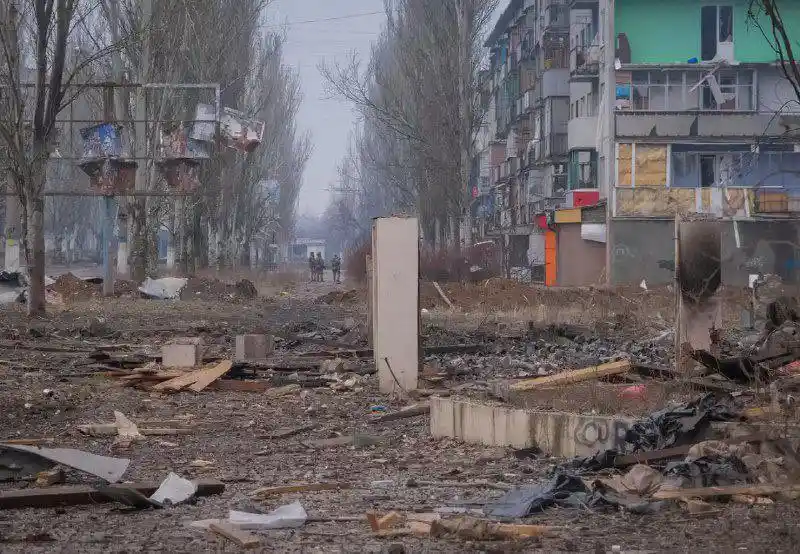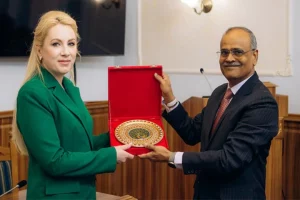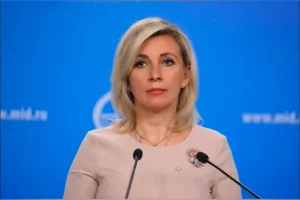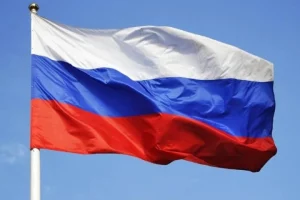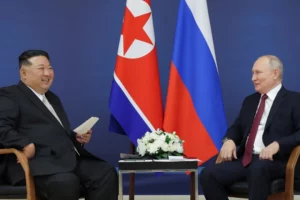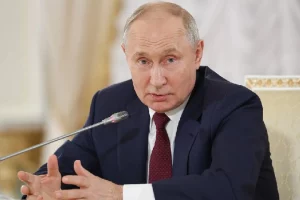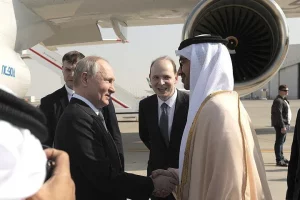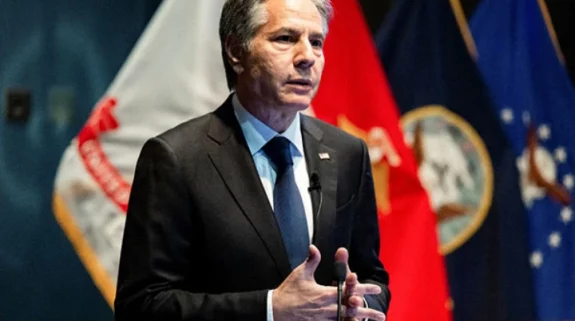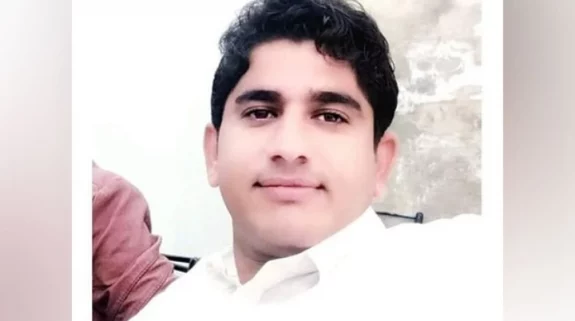A year has passed since the start of the Russian Special Military Operation in Ukraine. It began precisely as a Special Military Operation, it is clear today that Russia has found itself in a full-fledged and difficult war.
The war not so much with Ukraine – as a regime, not with a people (hence the demand for political denazification was put forward initially), but first of all with the “collective West”, that is, in fact, with the NATO bloc (except for the special position of Turkey and Hungary, seeking to remain neutral in the conflict – the remaining NATO countries take part in the war on the side of Ukraine one way or another).This year of war shattered many illusions that all sides of the conflict had.
The West was wrong in its calculations
The West, hoping for the effectiveness of an avalanche of sanctions against Russia and its almost complete cut-off from the part of the world economy, politics, and diplomacy controlled by the United States and its allies, did not succeed. The Russian economy has held its own, there have been no internal protests, and Putin’s position has not only not wavered, but has only grown stronger. Russia could not be coerced into stopping military operations, attacking Ukraine’s military-technical infrastructure, or withdrawing decisions to annex new entities. There was no uprising of the oligarchs, whose assets were seized in the West, either. Russia survived, even though the West seriously believed that it would fall.
From the very beginning of the conflict, Russia, realizing that relations with the West were crumbling, made a sharp turn toward non-Western countries – especially China, Iran, Islamic countries, but also India, Latin America and Africa – clearly and contrastingly declaring its determination to build a multipolar world.
In part, Russia tried already to strengthen its sovereignty, but with hesitation, not consistently, constantly returning to attempts to integrate herself into the global West. Now this illusion has finally dissipated, and Moscow simply has no way out but to plunge headlong into building a multipolar world order. It has already achieved certain results, but here we are at the very beginning of the way.
The Russian plans were drastically changed
However, in Russia itself everything did not go the way it was supposed to. Apparently, the plan was not to wait for Ukraine to attack Donbass and then Crimea, what was being prepared during the Minsk agreements with the active support of the globalist elites of the West – Soros, Nuland, Biden himself and his cabinet – but to strike a swift and deadly preemptive blow against Ukraine, rush to besiege Kiev and force the Zelensky’s regime to capitulate. After that, Moscow planned to bring a moderate politician (someone like Medvedchuk) to power, and begin to restore relations with the West (as it happened after the reunification with Crimea). No significant economic, political, or social reforms were planned. Everything was supposed to remain exactly as before.
However, it all went very wrong. After the first real successes, huge miscalculations in the strategic planning of the entire operation became apparent. The peaceful mood of the army, the elite, and society, unprepared for a serious confrontation – neither with the Ukrainian regime, nor with the collective West, had its impact on the development of the situation. The offensive stalled, encountering desperate and fierce resistance from an adversary with unprecedented support from the NATO military machine. The Kremlin probably did not take into account either the psychological readiness of the Ukrainian Nazis to fight to the last Ukrainian, or the scale of Western military aid.
In addition, we did not take into account the effects of eight years of intensive propaganda, which forcibly inculcated Russophobia and extreme hysterical nationalism in Ukrainian society day in and day out. While in 2014 the overwhelming majority of eastern Ukraine (Novorossiya) and half of Central Ukraine were positively disposed toward Russia, although not as radically as residents of Crimea and Donbass, in 2022 this balance has changed – the level of hatred toward Russians has significantly increased, and pro-Russian sympathies have been violently suppressed – often through direct repression, violence, torture and beatings. In any case, Moscow’s active supporters in Ukraine became passive and intimidated, while those who hesitated before sided finally with Ukrainian neo-Nazism, encouraged in every possible way by the West (I think for purely pragmatic and geopolitical purposes).
Even BBC agrees Azov battalion has neo-NAZIs.
BBC: “Mariupol is home to a Ukrainian militia unit called the Azov Brigade, named after the Sea of Azov which links Mariupol to the rest of the Black Sea. The Azov Brigade contains far-right extremists including neo-Nazis.” 2/3 pic.twitter.com/UN6I3gsPSe
— Harun Kimani (@IforumKenya) March 22, 2022
Only a year later, Moscow finally realized that this was not an Special Military Operation, but a full-fledged war.
Ukraine performed relatively well
Ukraine was more ready for Russia’s actions than anyone else, which it began talking about in 2014, when Moscow had no even remote intentions of expanding the conflict, and reunification with Crimea seemed quite sufficient. If the Kiev regime was surprised by anything, it was precisely Russia’s military failures that followed its initial successes. This greatly boosted the morale of a society already saturated with rabid Russophobia and exalted nationalism. At some point, Ukraine decided to fight Russia in earnest to the very end. Kiev, given the enormous military aid from the West, believed in the possibility of victory, and this became a very significant factor for the Ukrainian psychology.
The great disater for Russian pro-Western elite
But the biggest surprise of all was the very beginning of Special Military Operation for the Russian liberal pro-Western elite. This elite was deeply integrated into the Western world on an individual level, most kept their savings (sometimes gigantic) in the West and actively participated in securities transactions and stock market games. The Special Military Operation actually put this elite under a direct threat of total ruin. And in Russia itself, this habitual practice began to be perceived as a betrayal of national interests. Therefore, Russian liberals until the last moment did not believe that the Special Military Operation would begin, and when it happened, counted the days when it would end. Having turned into a long and protracted war with an uncertain outcome, the Special Military Operation was a disaster for the entire liberal segment of the ruling class. Until now, some are making desperate attempts to stop the war (on any terms), but neither Putin, nor the masses, nor Kiev, nor even the West, would accept it. The West has noticed the weakness of Russia, somewhat bogged down in the conflict, and along with Kiev will go all the way in its supposed destabilization.
Hesitating allies and Russian loneliness
Russia’s friends and allies were also partly disappointed by the first year of the Special Military Operation. Many probably thought our military capabilities were so substantial and well-tuned that the conflict with Ukraine should have been resolved relatively easily. And the transition to a multipolar world seemed for many already irreversible and natural, while the problems Russia faced along the way brought everyone back to a more problematic and bloody scenario.
It turned out that the liberal elites of the West were ready to fight seriously and desperately to preserve their unipolar hegemony, up to the likelihood of a full-scale war with direct NATO participation and even a full-fledged nuclear conflict. China, India, Turkey and other Islamic countries, as well as African and Latin American states, were hardly ready for such a turnaround.
It is one thing to get closer to a peaceful Russia, quietly strengthening its sovereignty and building non-Western (but also not anti-Western!) regional and interregional structures. And the quite other matter is entering into a frontal conflict with the West. Therefore, with all the tacit support of the partisans of multipolarity, especially China, Russia was left in this war with the West, in fact, alone.
All this became obvious a year after the start of the Special Military Operation.
The phases of war: beginning
The first year of this war had several phases. In each of them many things changed in Russia, in Ukraine, and in the world community.
The first abrupt phase of Russian success, during which Russian troops passed Sumy and Chernihov from the north and reached Kiev, was met with a barrage of fury in the West. Russia proved its seriousness in liberating the Donbass, and with a swift rush from Crimea established control over two more regions, Kherson and Zaporozhye. This phase lasted for the first two months. In a situation of demonstrable successes, Moscow was ready for negotiations that would consolidate military gains with political ones. Kiev also reluctantly agreed to negotiations.
2nd phase: the failure of impossible peace talks
But then the second phase began. Here the military and strategic miscalculations in the planning of the operation made themselves felt in full measure. The offensive stalled, and in some directions Russia was forced to retreat from its positions. Russia tried to gain something by peace talks in Turkey. But failed.
Negotiations became meaningless because Kiev felt that it could resolve the conflict by military tools in its favour. From then on, the West, having prepared public opinion with the furious Russophobia of the first phase, began to supply Ukraine with all forms of lethal weapons on an unprecedented scale.
3rd phase: stalemate № 1
In the summer of 2022, the situation began to stalemate, although Russia had some success in some areas. The second phase lasted until August. During this period the contradiction between the initial idea of Special Military Operation as a rapid and fast set of precise military strikes, which should have soon entered the political phase, and the need to conduct combat operations against a heavily armed enemy, which had logistical, intelligence, technological, communications, and political support from the entire West, became apparent in its entirety. And now a front was of enormous length.
Meantime Moscow tried to continue to lead the Special Military Operation according to the original scenario, without wishing to disturb society as a whole or address the people directly. This created a contradiction in the sentiments of the front and the home, and led to disagreements in the military command. The Russian leadership did not want to let the war inside the society, postponing in every way the imperative of partial mobilization, which had become overdue by that time.
Putin has accused Ukraine’s special services of planning the Crimea bridge explosion.
This is the first time the Russian president has directly linked the country to the attack. pic.twitter.com/uvLpt3oCnj
— DW News (@dwnews) October 9, 2022
During this period, Kiev and the West in general turned to terrorist tactics – killing civilians in Russia itself, blowing up the Crimean bridge, and blowing up the Nord Stream gas pipelines.
4th phase: Ukraine counterattacks
Thus we entered Phase 4, which was marked by a counteroffensive by the Ukrainian Armed Forces in the Kharkov region, which to this time had already partially passed under Russian control. The Ukrainians’ attacks on the rest of the front also intensified, and the mass delivery of HIMERS units and the supply of the secured satellite communications system Starlink to Ukrainian troops in combination with a number of other military and technical means created serious problems for the Russian army, for which it was not prepared. The retreat in the Kharkov region, the loss of Kupyansk and even the town of Krasnyy Liman in the DNR was the result of initial “half-war”. It was at this point that Special Military Operation turned into a full-fledged war. More precisely, this transformation was finally realized in earnest in the Russian upper echelons.
5th phase: partial awakening of Russia
These failures were followed by the fifth phase, that changed the course of the events. The announcement of partial mobilization, the reshuffling of the military leadership, the creation of the Coordinating Council on Special Operations, the transfer of the military industry to a tougher regime, the tightening of penalties for failure to fulfill the state defense order, and so on. The culmination of this phase was the referendum on accession to Russia in four subjects – the DNR, the LNR, and the Kherson and Zaporozhye regions, Putin’s decision to let them join Russia, and his fundamental ideological speech on this occasion on September 30, in which he stated, for the first time, with all frankness, Russia’s opposition to Western liberal hegemony, its complete and irreversible determination to build a multipolar world, and the beginning of the acute phase of the war of civilizations, in which the modern civilization of the West was declared “satanic”.
In his later Valdai speech, Putin reiterated and developed the main theses. Although Russia was already forced to surrender Kherson after that, while still in retreat, the attacks of the Ukrainian Armed Forces were stopped, the defence of the controlled borders was https://www.indianarrative.com/strengthened and the war entered a new phase. As the next step of escalation, Russia began regular destruction of Ukraine’s military-technical and sometimes even energy infrastructure with unstoppable missile-bombing strikes.
6th stage: new equilibrium — stalemate № 2
But gradually the front stabilized and a new stalemate developed. Now none of the adversaries could turn the tide. Russia has reinforced itself with a mobilized reserve. Moscow supported the volunteers and especially the Wagner “group”, which managed to achieve significant success in turning the tide in the local theaters of war.
This phase has lasted until now. It is characterized by a relative balance of power. Both sides cannot achieve decisive and decisive successes in this state. But Moscow, Kiev and Washington are ready to continue the confrontation for as long as it is necessary.
(Alexander Dugin, is a Russian thinker and the architect of the Fourth Political Theory. Views expressed are personal and exclusive to India Narrative)
Also Read: The Great Awakening: A scream in the night






